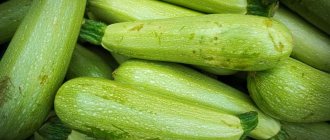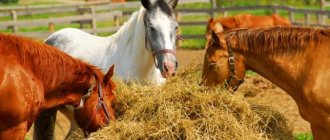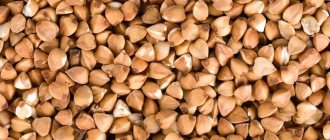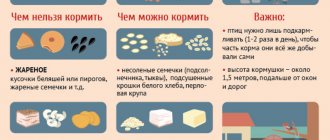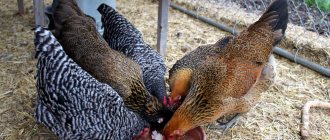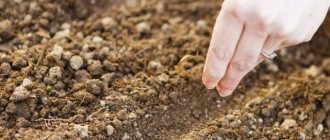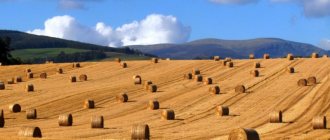Good afternoon, experienced and novice poultry farmers! In this material we will tell you what you can and cannot feed laying hens and broilers. Standard and balanced feed for feeding poultry is a given. Let's not dwell on this.
How and from what wet mash is prepared - read the link, everything is quite simple.
Today we will focus on unusual products that can be given. Only personal experience. These are not recommendations - this table is for your reference.
This is a list of almost everything you can safely feed your chicken. However, all chicks and adults have their own tiny brains full of likes and dislikes. Therefore, while some chickens may run for grapes or watermelon, chickens of a different breed or character will not react at all to the offered delicacies.
Everything on this list is definitely safe to eat and worth a try!
What can you feed chickens?
Please note that at the end of the article we provide a table of what you should not feed chickens!
| Product | In any form | General opinions |
| Apples | Raw materials and in the form of applesauce without sugar. | Apple seeds contain cyanide, but not in sufficient quantities to be harmful. |
| Asparagus | Raw or cooked. | They don’t like it, but they eat it in mash. |
| Bananas | No peel. | Fruits with a high potassium content are pecked with pleasure. |
| Beans | Only well cooked, boiled. | Fresh beans and tops are eaten well. |
| Beetroot | In any form, give the tops. | Raw grate, boiled whole. |
| Berries | All types. | This is the most delicious thing for chickens, take care of your plantings! |
| Bread | All types are better than stale pieces. | Feed in moderation, obesity! |
| Broccoli and cauliflower | Fresh and boiled. | Hang it on the wall and they'll be pecking all day long. |
| Cabbage and Brussels sprouts | Fresh and boiled. | In winter, hang whole cabbages from the ceiling of the coop to give them something to play with and eat. |
| Carrot | Raw and boiled. | They also like carrot foliage. Raw on a grater, but not much! |
| Cottage cheese | Super delicacy. | Fat and low fat love |
| Cheese | Besides the melted one, it’s an expensive pleasure. | Fatty product, but a good source of protein and calcium. |
| Boiled chicken | Eating your own kind? | They may like it and it's nutritious, but it just seems...umm...wrong. |
| Corn | On the cob and canned, raw and cooked. | Limited! Obesity. |
| Crickets, bugs, worms (live) | Can be bought in fishing stores (expensive). | A great treat - provides protein and is fun to watch the hens deal with them. |
| cucumbers | Only fresh ones. | Cut in half, leaving only the skin. |
| Eggs | Hard boiled ones are a good source of protein and a favorite treat. | Only in cooked form! If you give them raw ones, they will start pecking at their eggs! |
| Eggplant | Raw, fresh and tops. | Not everyone loves it, but they love it |
| Fish and seafood | Only in boiled form. | They also love raw fish, but we won’t risk it. |
| Flowers | Make sure they have not been treated with pesticides, just from your flower bed. | Marigolds, nasturtiums, pansies, etc. |
| Fruits | Pears, peaches, cherries, apples. | They love it! |
| Grains, cereals | Any. | No comments needed! |
| Grape | Only without seeds. For chickens, cutting them in half makes them easier to swallow. | Chickens play with whole grapes like football! |
| Oatmeal | It's better to steam it. | They eat with pleasure. |
| Leftovers from the table | Any! Just not spoiled!!! | We do not recommend: pickles, jams, marinades. |
| Spices | Any leafy green we add to dishes, fresh or dried. | They like it! |
| Yogurt | Any. | They eat with passion! |
| Meat waste | Not too fatty, raw and boiled, chopped. | Good source of protein in moderation. |
| Melon | Seasonal buzz. | Both the seeds and the pulp make good chicken treats. |
| Oatmeal | Raw cereals or leftovers from your table. | Cooked better, be careful - obesity. |
| Pasta | Cooked pasta, spaghetti, etc. | A favorite treat, it's fun to watch the chickens eat spaghetti. Infrequently! |
| Peas | Fresh peas and pea tendrils, leaves and flowers. | They gobble it up with pleasure. |
| Sweet pepper | Fresh. | Not everyone loves it! |
| Grenades | To cut in half. | The kernels are great fun. |
| Popcorn | If only without oil and salt. | They'll peck quickly. |
| Potato | Only boiled - avoid green peel! | Products with a high starch content should not be given frequently. |
| Pumpkin | Raw or cooked. | Both the seeds and pulp are a nutritious treat. |
| Raisin | Anything, but expensive. | Swept away instantly. |
| Rice | Boil, or cook until half cooked. | Try giving pilaf - that's where the feast begins! |
| Watermelon | Peels and pulp. | Peel down to the holes in the peel. |
| Sprouts | Sprouted wheat, oats. | This is instead of greenery in winter. |
| Zucchini, zucchini | All varieties in raw and cooked form, even squash. | Not much of a treat, but some people eat it! |
| Sunflower seeds | Seeds in the shell are good for both feeding and shelling. | A good delicacy, some chickens know how to shell them, they only eat the grains! |
| Tomatoes | Raw and cooked. | Not for everyone. |
| Turnip | Steamed. | They don't eat much. |
Second place
Surely many breeders and fanciers have heard or read that small quantities of fish and meat are beneficial for chickens. This is true, but not smoked products! So, if you have bones, ridges or other remains from salted or smoked fish, do not give them to your chickens, as inexperienced breeders are in a hurry to do. A large amount of salt in these products will definitely not benefit them. Including smoked meat products should not be present in the diet of your birds.
Photo
My favorite chicken treat of all is worms! Pay attention to the lightning speed when pecking, this is a reaction!
Yogurt is my hens' favorite food and it's great for gut health.
And in this photo, the chickens came running to enjoy kefir.
In the photo, a Wyandotte rooster is jumping for peanuts.
Wow! What is this? Can you eat this, is it tasty?
Here's a bowl of warm oatmeal, girls!
Warm oatmeal tastes even better after a big snowstorm.
Some leftover rice with vegetables.
Application of compound feeds
Is it worth it or not? Owners of large farms talk about the convenience of using compound feed. It is recommended to select specific feeds designed for your type of poultry. For example, there are certain foods on sale today that increase egg production. If you are raising meat breeds, then the food should not contain components that reduce weight gain.
In terms of nutritional value and composition, ready-made food is in no way inferior to natural food. From 60 to 70% of the composition is oats, bran, millet and barley. 20-30% are corn and legumes. The food also includes berries, vegetables, vitamins and minerals, bone meal, milk powder and dried herbs.
What not to feed chickens
| What not to feed chickens | Why can't you feed chickens this? |
| Raw green potato peel | The toxic substance is called Solanine. |
| Something really salty | May cause salt poisoning. |
| Citrus | Chickens also suffer from allergies. |
| Beans are dry or undercooked | Raw or dried legumes contain a poison called hemaglutin, which is toxic to birds. |
| Candy, chocolate, sugar | Chickens will develop tooth decay... no, it's just bad for them, and chocolate can be poisonous to most pets! |
| Raw eggs | You don't want to introduce your laying hens to the taste of eggs that are already lying in nests waiting to be collected. |
I was disappointed in my laying hens, studying what to feed the chickens, what is best for them, at the moment when I caught them all, when they had almost finished dealing with the foam from the packaging from the juicer...
Read about which herbs are dangerous for chickens and hens in this article, about beneficial and harmful plants for poultry.
How to prepare food
In a chicken’s diet, 70% is grain feed, the rest is protein feed (plant and animal) and green. The food needs to be crushed to make it easy to peck.
- Animal food: boiled ground meat, fish, bone meal.
- Vegetable – mushrooms, vegetables, fruits. Depending on the season, nutritional proportions change.
- In summer there is more plant and green food, in winter - animal and grain food. If the birds are not freely grazing, then they must add salt and sand, which are necessary for digestion.
- Sand helps to grind food inside the intestines and digest it.
Important! When a chicken walks around the yard, it pecks at the soil. This way the bird receives enough auxiliary substances into the body, so there is no need to add sand to the diet in the summer.
- To ensure that the bird has enough minerals, seashells are crushed, chalk, limestone, and eggshells are added. The shells are washed and crushed, otherwise the chickens, in search of delicacies, begin to peck at their own eggs.
- Millet, millet, barley, rye are the grain base of chicken feed. Millet boiled in water can be given to chickens. Corn is a fatty grain, so it is added to about 5-6% of the grain base.
What to feed chickens in winter for egg production
In addition to standard feed and table scraps, I give 1 kg of chicken bone scraps per 10 heads once a week. What is a bone remnant? Almost all poultry farms finely grind bones, skin and something else...
Packed 1 kg in boxes of 12 pieces. Price in the markets of Chelyabinsk: 15 rubles per kilo. This option was recommended to me by a feed seller. She has been feeding laying hens in winter for egg production for many years.
This is our third winter now, no problems. Although skeptics argue that with such food, chickens may develop pecking. They will start pecking at each other.
Here is a photo of what this feeding looks like. Just took a photo with flash. Today it’s -25ºС (December 24), it’s 20 o’clock and I’m starting to watch “Vesti” on Russia-1.
With this I will say goodbye to you. Andrey.
Subscribe to our email newsletter and be the first to read the latest chicken news! Don’t forget to tell us in the comments what you tried to feed your chickens.
Did you like our tips? Share with friends on social media. networks!
Greenery
An irreplaceable feed in the diet of chickens, especially laying hens. In summer, the feed mixture should contain 20-30% greens; in winter, this figure is increased to 50%.
It is a source of vitamins B1-B6, C, minerals, and fiber. It is the main supplier of vitamin K to the bird’s body, from which the liver produces blood clotting factors and helps strengthen capillaries.
With its deficiency, vascular permeability increases, and there is a risk of bleeding. The main sign of vitamin K deficiency is the appearance of blood spots on eggshells in laying hens.
Dry greens are introduced into the diet of chickens already in the first week of life. Chicks raised in an incubator should be given 2-3 grams of dry grass already on the 3rd day.
Stinging nettle is a valuable herb for chickens.
Also useful:
Harmful grasses include:
Grass collected from roadways, household waste dumps, and places with hazardous industries contains harmful substances and carcinogens in large quantities. Therefore, it is unsuitable as food.
Contraindications and harm
Sunflower seeds are considered a safe and healthy food for poultry, so they have virtually no contraindications. However, they should be included in the diet carefully. It is strongly not recommended to use sunflower for feeding chicks and young animals younger than 25–30 days.
This is due to the fact that these seeds contain a lot of fats, which often negatively affect the fragile digestive system of chicks. In this case, the seeds can cause severe diarrhea and other digestive system disorders.
You should not overuse the seeds when feeding adult chickens. As a result of excessive consumption of fats, the product can cause severe obesity. This threatens quite serious problems not only for health, but also for the productivity of chickens.
Obesity contributes to the deterioration of the cardiovascular system and metabolism, which can ultimately cause the death of the bird. In addition, excessive weight negatively affects the egg production of chickens, as well as their ability to instantly gain muscle mass.
In this case, obesity can cause the loss of the agricultural value of the poultry and serious losses for the farm.
Drinking regime of laying hens
Chickens have vital access to drinking water. Depriving the bird of drink for 2-4 days will lead to a complete cessation of egg laying. On average, one laying hen weighing about 1.75-2 kilograms drinks 235-250 ml of liquid per day.
Watering is provided in several ways. The simplest is a bowl or pan with water. In this case, it is necessary to renew the fluid throughout the day, as it may become contaminated. Chickens also often knock over containers.
A more modern way is to use nipple or vacuum drinkers. In this case, the water remains clean. But remember that the drinking bowls must be periodically washed to remove mucus, greens, etc.
What grass should I give to adults?
The feed mixture may contain 15-30% green components. Adults should be given herbs such as plantain, nettle, alfalfa, wood lice, dandelion, wheatgrass, clover, cereals, spurge, and sorrel. You can also include legumes and durum vegetables in your chickens' diet. Cabbage leaves are a good source of vitamins. You can also include beet tops, green onions, dill, and parsley in the diet for chickens. Amaranth is high in healthy proteins.
Combination with other foods
The correct combination of foods consumed at one time plays a huge role in the correct digestion of animals and reducing the likelihood of intoxication of the body from the processes of rotting and fermentation in the stomach and intestines.
Stone fruits are best combined with other fruits. An ideal vitamin tandem would be an apple and carrots. But for some animals, this fruit is best served separately and in its pure form. Because with a mixed diet, a problem often arises when one product interferes with the absorption of another.
Alternative sources
The expected increase in poultry meat production directly affects the availability and price of feed. Thus, in the United States, from 2005 to 2015, corn prices increased by 71%, according to the US Department of Agriculture. This indicates the importance of alternative sources in poultry diets. Processing of roots, tubers and fruits for food and industrial purposes removes residues of low economic value in the form of peels and pulp. Using these residues as feed will also have a positive impact on the environment.
Starch-rich roots and tubers are important food crops, with annual global production estimated at 836 million tonnes (FAO, 2013).
Taking into account that the mass of the peel is 15–20% of the mass of the tuber, it is possible to estimate the amount of peel obtained during the processing of these crops. Most fruits have an even higher peel yield than tubers. Peel yields of 31% and 40% were recorded for papaya and banana, respectively. In addition, huge amounts of these fruits are wasted, with about 30–40% of bananas being discarded due to defects and damage (FAO, 2012). The citrus pulp remaining after juice extraction accounts for up to 50–70% of the fruit's weight.
Some examples
Sweet potato
Sweet potato skins are high in energy, moderate in protein, and low in crude fiber. Scientists found the value of crude protein and crude fiber to be 36–46 g/kg and 38–70 g/kg, respectively, and metabolizable energy to be 11.25 MJ/kg. Colored sweet potato varieties are good sources of carotenoids, which may reduce the need for pigment additives for normal egg and skin pigmentation. Phenolic compounds have also been found in sweet potato skins.
Planting chicken feed in the garden and top 3 favorite chicken weeds
With rising prices for feed, most poultry farmers are looking for options on how to save on feeding chickens. It turns out that you can greatly simplify enriching the diet of poultry with the help of simple weeds, and also spend time planting additional cultivated plants in the garden
In order to make a chicken garden, you need to consider how much certain plants produce in a small area and how easy it is to feed the birds with them. As a rule, few people want to cook for chickens as well.
Usually you will only have to buy seeds once, and then save them in reserve for the next season. There is no need to worry about weeds at all. These resilient plants reproduce by self-seeding without any assistance.
For obvious reasons, you are unlikely to give your chickens free range in the garden, except in the spring, when the weeds are the first to appear. As the season continues, poultry will simply destroy your beds, which means they should be confined to an aviary, delivering food there.
Composition of grain mixture
Many farmers prefer grain mixtures made at home with their own hands. In this case, you can accurately track what grain and in what quantities was added to the mixture, as well as what else is there. It is very important to maintain certain proportions when preparing.
Approximate number of components in grams for preparing 1 kg of grain mixture for laying hens (winter-spring version):
- crushed corn - 450;
- wheat - 120;
- barley - 85;
- Sunflower meal - 70;
- feed chalk - 70;
- meat and bone meal - 60;
- fishmeal - 50;
- feed yeast - 40;
- herbal flour or granules - 30;
- split peas - 20;
- salt - 5.
Another option for preparing 1 kilogram of grain mixture, the components are indicated in grams (summer-autumn version):
- wheat - 550;
- barley - 150;
- wheat bran - 50;
- sunflower cake - 100;
- shell - 50;
- meat and bone meal - 40;
- feed chalk - 25;
- vegetable oil - 20;
- salt - 5;
- premix - 10.
A properly prepared grain mixture is suitable for purebred chickens. To feed highly productive crosses, it is recommended to use industrial feed. If chickens are fed only grain mixture, the daily norm for one chicken is 140-180 grams.
Note: as in the case of mixed feed, grain mixtures can be given in any form (both dry and soaked/steamed).
Is it possible to give radish tops to chickens?
Also good for birds are clover, alfalfa, parsley, and radish tops.
, young green needles and tree leaves are mixed into the feed.
Chickens
are very fond of an ornamental plant called kochia.
Interesting materials:
Why doesn't the Canon mp280 scanner work? Why doesn't my Epson scanner work? Why doesn't screenshot work on Android? Why doesn't Skype work? Why doesn't the speedometer work on the Lada Granta? Why doesn't the link in telegram work? Why doesn't Starline work? Why doesn't the stylus work on my tablet? Why doesn't the stylus work? Why doesn't the brake light work?
